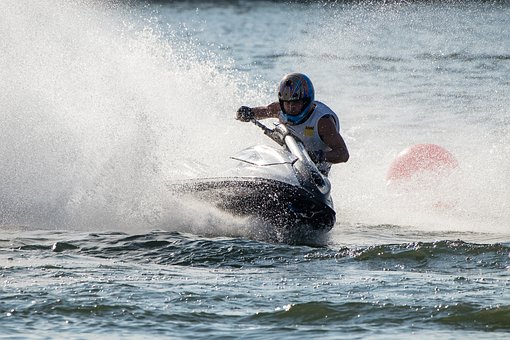
Jul 23, 2019
JET SKIS and THE LAW
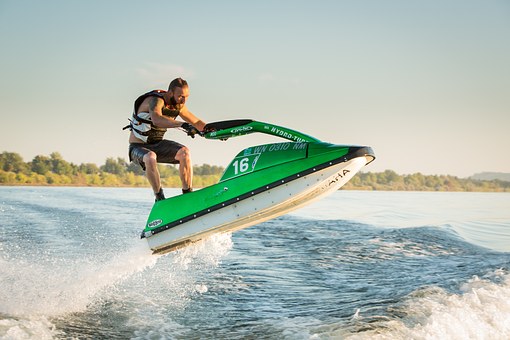
Stand-up PWC
State & Federal law has a lot to say about how you operate your Jet Ski.
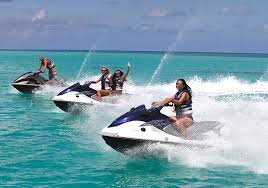
Keep 100 feet apart
Many people don’t realize there are legal ways and some NOT so legal ways to operate a PWC or jet ski.
Beyond the usual title and registration that everyone expects, there are specific laws that apply to PWC’s.
Who can operate a jet ski?
In Wisconsin, a person younger than 12 years of age, may not operate a PWC or jet ski.
12-15 years olds may operate a pwc ONLY If they have completed a boating safety course. The Wisconsin DNR must accept the course. Sorry, you can’t substitute parental supervision for this course.
A person at least 16 years old may operate a PWC only if they have completed an accepted boating safety course.
Were you born before Jan 1, 1989?
You are exempt from the course requirement.
No one under 16 years old may rent or lease a PWC.
Remember if you have taken the proper courses, you must carry a copy of the certificate with you and make it available to law enforcement officers when requested.
In addition to the U.S. Coast Guard, Wisconsin conservation wardens, county sheriffs, and municipal police enforce the laws.
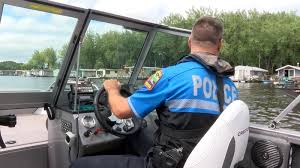
Boat Safety Rule #3- Don’t get a visit from him
Just like driving a vehicle, it is illegal to:
- refuse to follow the instruction of a law enforcement officer.
- A pwc operator must slow to “no-wake” or “slow” and give way to a patrol boat if it’s emergency lights are on or if they signal you to stop.
- You must stop when requested or signaled by a law enforcement officer or patrol boat.
- Furthermore, you must reduce speed to “slow” or “no-wake” and stay at least 100 feet from a patrol boat with its emergency lights activated. It’s similar to pulling into another lane when you see an emergency vehicle on a roadway.
You must have the legally required equipment on board at all times including:
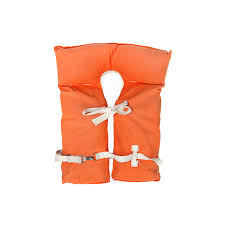
Boat Safety Rule #1- Everyone needs one
- PFD (personal flotation device or life jackets) even on canoes and kayaks.
- Kids under 13 must WEAR their PDF while underway on a pwc on federally controlled waters.
- EVERY person on a pwc MUST wear an approved PDF.
- You must wear the proper size PDF, and it must be in good and serviceable condition. No tears, rips, broken straps, or snaps.
Do I need a sound-producing device (Horn) on a PWC?
No! UNLESS you are on federally controlled waters like Lake Michigan.
Are we done? Not Really!
It is against the law to operate a vessel in a negligent or reckless manner such as in a manner that causes danger to life or limb.
Here are some examples:
Operating a vessel within 100 feet of the shoreline, a raft or pier at speeds higher than “no-wake” or “Slow.”
Jumping the wake of another vessel that is towing someone;
Operating a pwc within an area which is marked off for swimming;
Weaving your craft through congested waterways;
Causing hazardous wave or wake conditions while passing another vessel;
Steering toward another object or person and swerving at the last moment; or chasing, harassing or disturbing wildlife.
Overloading your vessel
If you have a pwc rated for two people, that is the maximum number you can have on it at any time regardless of weight or age.
These are just some of the laws you must follow.
Think of operating a vessel like you would a car. If it’s not legal in a car or truck, don’t try it on the water. Example – Do NOT drink and drive!!
Visit the DNR website at www.dnr.wi.gov and enter “boat safety” to find acceptable boating courses. Also, look for https://dnr.wi.gov/files/pdf/pubs/le/le0301.pdf
To read part one of this series go to https://wisconsinpws.com/pwc-jet-ski-users-guide
Keep us all safe, and we’ll all enjoy the water more on a PWC.
Do you have a friend that might be interested in this post? Please forward it to them.
Pier & Waterfront Solutions
PWS is located at 7325 St. Hwy 57. That’s 1 mile North of County MM (Hwy 42) and 3 miles south of Sturgeon Bay at the Idlewild Road intersection. Or – for more information, you can call Jerry @ 920-493-4404.

Jul 16, 2019
Are there different Styles?
Yes, they come in two styles: Stand-Ups and Sit-Downs.
Both styles use water to create thrust to provide propulsion. The propulsion also controls the steering. Therefore, the motor has to be running to use either or both features.
Stand-up jet skis require a great deal of balance as any experienced operator will tell you. I suggest that your first jet ski ride happens on a sit-down unit.

Stand-up PWC
Stand-ups are not easy to control, and a strong wave can easily throw you off balance. That means you are going for a swim, whether you want to or not!
You have greater control on a sit-down from a slow idle to full speed ahead. The sit-down type is more comfortable to ride, and, if maneuvered correctly, you don’t even have to get wet! But who wants that! The wetter you are, the better.
Before your first trip on a PWC (here comes the checklist)
Jet ski riders do get injured; which makes it important to familiarize yourself with the specific watercraft you’ll be riding.
Injuries?? From what?! How about getting thrown off your ride for one. It’s very easy to do when you are turning at full speed. It’s exciting also.
Despite this, safety should be your first concern – both for you, your passenger, and people in the immediate area.
Know your machine’s controls and capabilities! Know your abilities as well. Different brands will have different controls, so make sure you know what’s the throttle and what’s the emergency shut off. Throwing the wrong switch could be very embarrassing (and dangerous).
Make sure you have enough fuel and all the proper safety equipment too.
My First Jet Ski Ride – what do I need to take with me?
The U.S. Coast Guard considers a PWC to be a Class A vessels. Therefore you must follow all rules and regulations for boats under 16 feet. Before that ride, make sure you have the required safety equipment. Not only to satisfy the Coast Guard but for your own safety as well.

Boat Safety Rule #1- Everyone needs one
Wear Coast Guard-approved life jackets/PFDs at all times. It’s a law that you and passengers can live with! Dress appropriately in a wetsuit, if possible. Wear simple feet protection and don’t forget eye protection. In most cases, your face will be pelted with stinging water while on your ride.
Check if your state requires a license while operating a PWC. If so, you may have to take a jet ski safety course to qualify for your license. The course may make you eligible for a PWC insurance discount too! Carry the proper documentation, such as vessel registration. It’s wise to have some form of identification also in case you are incapable of responding.
Secure a Coast Guard-approved fire extinguisher onboard if possible.
What else should I have?
Carry an audible signaling device, such as a whistle or horn. Don’t forget to check your fuel gauge. You will forget the time (a good thing for most of us) but bad if you run out of daylight or fuel! The driver of the jet ski must wear a lanyard around their wrist, which is attached to the key in the ignition. It’s known as a kill switch cord. The kill switch will turn off the engine in case the driver gets thrown off the unit. Some models may shut down if the throttle is released (as you go flying through the air).
Back at the dock, don’t forget to remove the cord! It stops any unauthorized use, whether preventing theft or safely securing the jet ski from daring young teenage riders.
What do I do if I fall off?
No doubt you will fall off, so here’s what you do.
Don’t panic. Re-boarding is a breeze if you follow these steps!
1. Turn the unit over from the side but watch the steering. It might hit you if you’re not careful.
2. Swim to the stern (back) to re-board. Re-boarding from the side may cause the unit to flip over, right on top of you.
3. There are handles or straps on the back of the seat. Use them to pull yourself up.
4. Move forward to the seat and don’t forget to re-attach the safety lanyard.
5. Of course, you were wearing a life preserver all this time.
Riding a Jet Ski with Passengers
It’s no surprise you will become very popular with your friends and family. They all want to ride on, or better yet, drive it themselves. If so, there are some extra steps to follow:
Carry only the permitted number of passengers that the jet ski allows. Don’t pile the kids on even for a slow speed ride. Make everyone wait their turn. Don’t forget there is a weight limit also. You must follow that limit.
All passengers must sit behind the driver.
Whenever the jet ski’s moving, have passengers secure themselves onto the seat straps provided. They will be the first to get thrown off the unit in a sharp turn at high speeds.
Make sure no one places their feet in the water while you are moving.
Demonstrate the basics of driving a jet-ski to all passenger’s. Why? If the driver becomes injured, it could come in handy! Make sure they know how to re-board if they are thrown off and you are injured.
Lookout for blindspots while turning.
Riding jet skis is a fun-filled summer pastime, but only if you do it correctly and safely. It takes practice. With practice, you’ll be ready when your time comes.
Be safe but have fun. Get out there and ride!
Next week we will talk about jet skis and THE LAW! https://wisconsinpws.com/jet-skis-the-law/
Do you have a friend that might be interested in this post? Please forward it to them.
Pier & Waterfront Solutions
PWS is located at 7325 St. Hwy 57. That’s 1 mile North of County MM (Hwy 42) and 3 miles South of Sturgeon Bay at the Idlewild Road intersection. Or – for more information, you can call Jerry @ 920-493-4404.
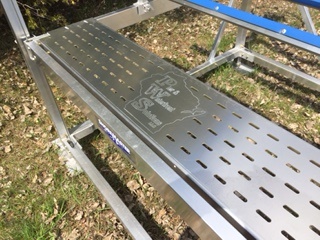
Jun 18, 2019
WALKING PLATFORM FOR JET SKI LIFTS
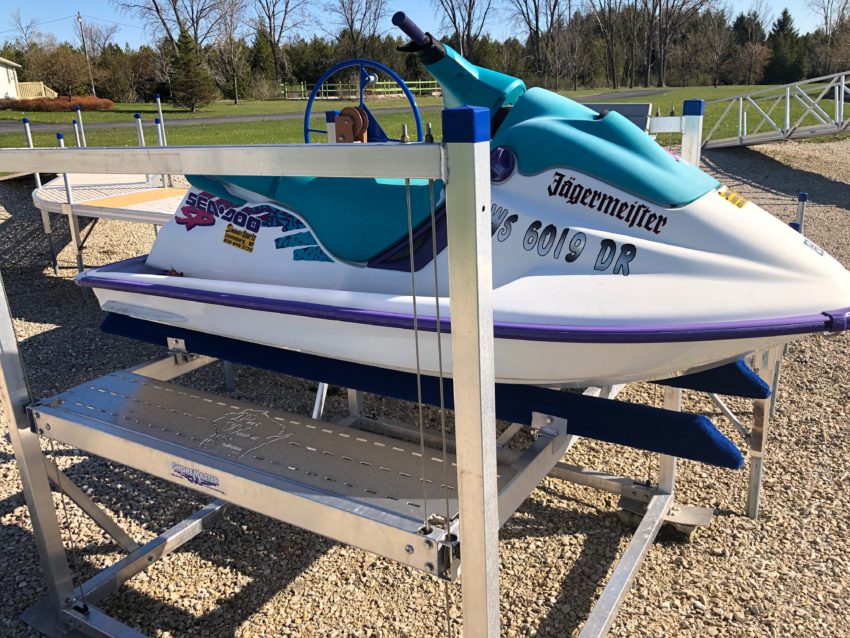
Walking Platform
A walking platform for your ShoreMaster vertical jet ski lift is an essential add-on from Pier & Waterfront Solutions. These stainless steel walking platforms are made exclusively for the SM 1064 and SM 1264 jet ski lifts (PWC lifts).
The walking platform consists of a stainless steel, perforated platform that mounts securely to the lift rack. The platform never rots and is extremely strong. It’s simple to install – one 9/16″ wrench is all you need. No drilled holes required
A stainless steel walking platform provides a stable platform for loading, refueling, or working on your jet ski.
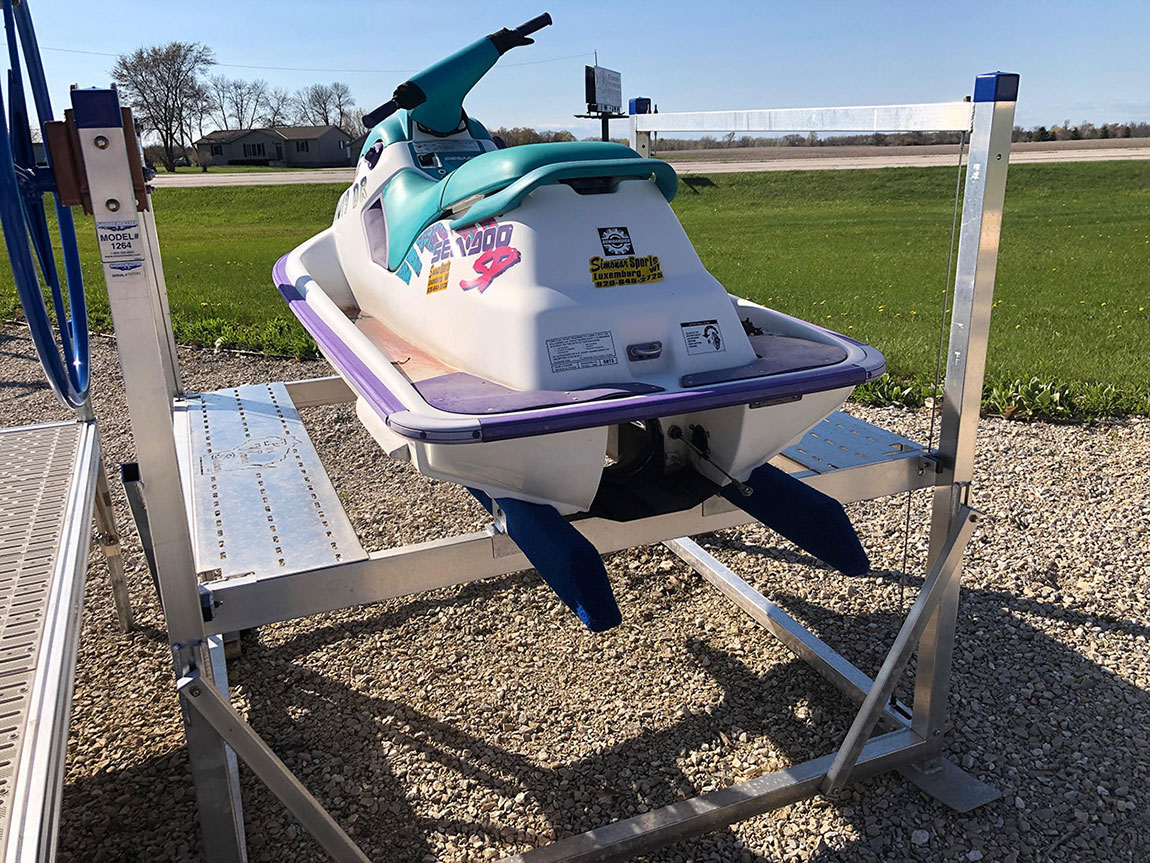
Duel walking platforms
The platform allows easy access to both sides of the jet ski. With access on both sides, the platform will enable you to put a cover on while high and dry.
Why scramble over your jet ski to put a cover around it? Why get tossed around by the waves while trying to work. There won’t be any more standing on the lift rack where the risk of falling off or injury is the greatest.
Imagine being able to service and refuel your jet ski without having to stand in the water or pulling it up on the rocks. Now you have a loading platform to set your equipment on when working on the engine or re-fueling your unit. You can do all kinds of work and stay dry.
Want more?
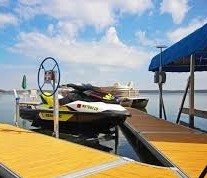
ShoreMaster winch tube extension
How about a winch extension post which allows you to reach the winch wheel from your dock? The aluminum extension post comes in a kit and will enable you to move the winch up, so you have better access to the winch wheel. A dock set high out of the water will no longer be a problem. No need to lay on the pier to reach the wheel?
Where can you find Pier & Waterfront Solutions?
We are located in the center of the Door County Peninsula at 7325 St. Hwy 42/57. That’s 1 mile North of County MM (Hwy 42) and 3 miles South of Sturgeon Bay. Look for the Idlewild Road intersection.
Don’t forget – Give us a call If you have a dock or boatlift topic you would like to see addressed on our site.
Call Jerry at 920-493-4404 or Email Jerry@wisconsinpws.com for more information.
May 15, 2019
IS THE WATER LEVEL GOING TO BE HIGHER THIS YEAR?
The water level WILL be higher – by a long shot!
We have many terrific customers. One customer has been following the Bay of Green Bay water conditions for years using government supplied data to ensure accuracy. We rely on Bill A. for his knowledge of current, as well as past, Bay water level history.
According to Bill A.:
Water levels are running very high in comparison to the Army Corp average numbers. The average for May is 580.75 ft. The readings he sees at the monitoring station near Green Bay has been peaking out at 582.47 ft which is 20.64 inches above the predicted average for May. An additional update from Bill A. shows that we are going to set a new record high if we continue to get rain this month.
The low-end numbers are around 581.05 ft which is 3.6 inches above the average for a typical May. Our current water level has been between 7.56 inches to 26.64 inches higher than May of last year (when we are at high tide).
What do all these water level numbers mean?
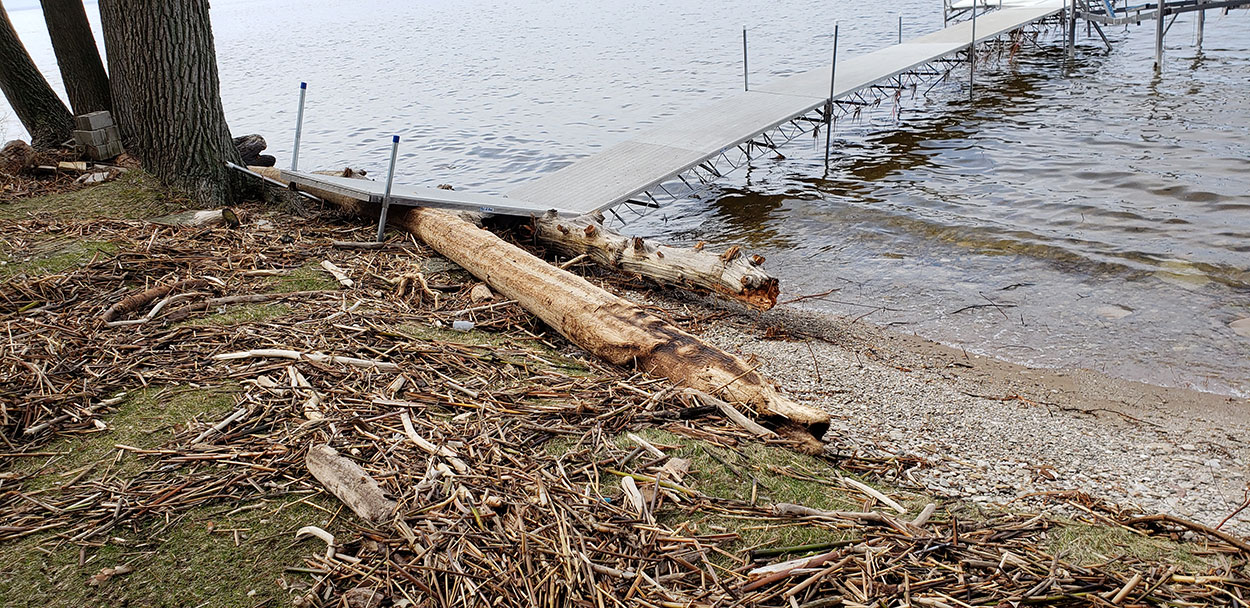
Storm Damage caused by floating logs
First, you can expect deeper water levels through-out the summer months.
Second, when there are storms, you will see the water reach higher onto your beach along with more turbulence.
Third, with the higher water levels, there is likely to be more floating debris (logs, rafts and floating boats).
What Do Higher Water Levels Mean for Installs?
With near record levels for water depth, it means all docks have to be raised again this year. This helps protect them from the storms.
That’s not a big deal in a normal year. The problem this year is that many docks already had short legs last year.
With water levels nearing historic levels, we have to take a great deal of time at almost every site to change the leg lengths. The extra time required to change the legs out means we are getting far less installs done per day than previously. Shortages in the labor market have compounded the problem. We can’t get enough people to make another crew despite better than average wages.
What can you do?
If your dock is not already installed, please give serious consideration to allowing us to lengthen the legs. In fact, we’ll go a step further and recommend that you contact John directly, (920-493-4405). Give us permission to shorten your dock length this year OR change the leg lengths on your dock, if needed.
Simply by not installing all the sections of the dock, you may avoid the need for longer legs. That’s not a guarantee if the water continues to rise but it may get you through this year.
What Else Can You do?
1. Keep your boat secure on your boat lift. It’s better to have your boat bouncing up and down on the boat lift than floating into your dock or your neighbors’ dock.
2. Keep your possessions higher on the beaches. The breaking waves may come further up on the beach and sweep them away.
3. Check your boat lift cables. Consider replacing any frayed or rusty cables. The added stress of high waves will break already weakened cable. See this post.
4. Keep your boat as high as possible on your lift. At the same time, be sure you don’t hit the top of the cable travel. Be especially careful with electric winches.I
5. If you see logs or large debris washed up on the shore near you, try to move it up to the higher ground to prevent it from floating out again.
6. Check your insurance coverage. SEE this related article.
Thank you Bill A. for providing the information for this post.
For more background about the water levels, see this article.
Do you have a friend that may be interested in this information? Please share a link to this page with them.
PWS is located at 7325 St. Hwy 57. That’s 1 mile North of County MM (Hwy 42) and 3 miles South of Sturgeon Bay at the Idlewild Road intersection. Our staff is here year-round to assist you.
Apr 30, 2019
INSURANCE FOR YOUR BOAT LIFT

Insurance Forms
With insurance, you expect EVERYTHING you own to be covered for damages. Even your dock and boat lift. But is that the case?
Here in Wisconsin, if you own a dock or boat lift, you have made a sizable investment. Of course, you want to make sure that they are insured. We urge you to make sure that all of your water equipment is protected. Insurance can be complicated, so you do need to talk to your agent. Make sure they research all scenarios.
Let’s discuss the various situations you may encounter.
Boat Insurance
Boat insurance is no different than auto insurance. But what exactly does the boat insurance cover? Boat lifts are not generally covered under a dock or boat policy. Boat insurance only covers the vessel itself. Think about it – your garage is not covered under your auto policy. Why would your boat, dock or lift be any different? Typically you have to have a rider to ensure your dock or lift.
Homeowners Insurance
Most homeowners believe that their dock and boat lift are part of their property. They think their homeowners’ insurance should cover them. Unfortunately, that’s usually not the case. Your dock may or may not be covered by your homeowners’ insurance.. Be sure to ask about it. Is your agent aware of it’s value?.
Liability insurance
It’s vital that you have not only physical damage but also liability insurance for your dock. Docks can be dangerous, and you’ll want to make sure you’re covered if someone were to get hurt on your dock. As for the physical damage coverage, make sure you understand what circumstances are covered, wind, fire, and snow all need to be considered.
Some Questions to ask your Insurance agent
Do you need:
Storage Insurance – Just like renters insurance you should consider storage insurance when your boat is not in use. Storage insurance can provide another layer of protection. The good news is there is less risk of liability while your boat is in storage. The insured premiums usually are reduced during that period.
Comprehensive coverage – This usually covers theft, accidental loss, or damage.
Replacement Costs – If you want to replace your boat after an accident, you will need to have coverage that is close to the current market value of your boat. You can adjust it to account for depreciation at each renewal.
Trailer Coverage – If you have a boat, you probably have a trailer to transport it around. Do you have coverage for your trailer and it’s cargo while being moved?
Accessory Equipment – Does your insurance cover your navigational equipment, lighting, and stereo systems and the other “toys” you added to the boat over time.
Mileage Restrictions – Does your policy restrict your mileage from where your boat is stored and used? Which insurance covers the boat while being transported to and from the storage unit?
Salvage insurance – What policy pays if your boat sinks after an accident or if you forget to replace the drain plug?
DOES YOUR INSURANCE POLICY COVER:
Geographic Limitations – Your insurance policy may have specific physical or bodies of water limitations. Going to take your boat around the country? You may need a plan that will cover it under those circumstances.
Good news: Your dock or boat lift, while stored on your residence premises (not necessarily in the water) would be covered by a standard Homeowners policy. It should be handled under a structure or as personal property. It will, however, be subject to the policy deductible. However, there may be other considerations.
WAVE DAMAGE – Damage to your lift or dock is NOT going to be covered if it is the result of waves. Even if the water is driven by the wind, it probably won’t be included. If wind-driven waves knock your dock or boat lift over, you will be responsible for damages. An exception might be if the waves caused a log, another dock or a boat to strike your equipment. The problem is, you have to prove it. If you see this situation happening your best option is to take photos. Better yet, a video of it happening might increase your chances of being covered. If the wind directly causes damage to the dock or lift, that loss should be covered by your insurance. Example, a dock accessory has blown off the dock by the wind, is probably covered under your policy.
WHAT ABOUT:
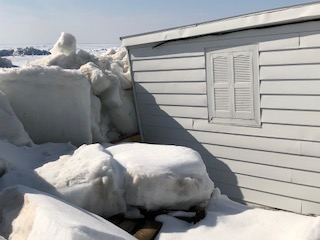
Ice Damage
ICE DAMAGE – Your dock or lift is not covered by damage caused by ice. If you leave your dock in the water over the winter and moving ice destroys it during the spring thaw, your Homeowners carrier is likely to deny that claim. Or if you leave your boat lift in the water and the pressure from freezing or thawing of the ice around it causes damage, again, this is most likely not covered. What if our dock is stored on your beachfront or lawn. If an ice shove occurs will it be covered? If your equipment is stored on your neighbors property and the ice gets to it, is it covered? Remember, it isn’t on your Resident Premises. See below for more information.
Beyond these circumstances, there are other circumstances where coverage could hinge on whether your dock or lift is considered a structure or personal property. This can matter because policy coverage provisions for structures and personal property are entirely different.
HOW IS YOUR DOCK DEFINED?
PERMANENT DOCK – If your dock or lift is permanently set in place and attached to its location, it is almost certainly a structure. But is it covered under your policy? The answer to this question may depend on which insurance company you ask. (This means you probably need to ask.)
PORTABLE DOCK – Most Wisconsin property owners remove their docks and lifts for the winter to protect them from ice damage. In that case, Is a movable structure still a structure? If your portable dock or boat lift is not considered a structure, then it should be regarded as personal property and typically covered against loss caused by one of the perils named in the policy. It includes fire, vandalism, and falling objects, among other damages. The other good news is that, as personal property, your dock or lift is covered anywhere in the world, even if it isn’t located where you live. Maybe.
What is the deductible?
However, the big question is – Is your dock or boat lift covered while in the water? You need to ask your agent.
DEFINE STRUCTURES
Things can get a bit more complicated if your dock or lift is considered a structure. First of all, most Homeowners policies only cover structures located on your “residence premises.” So if you own a dock or lift situated in a resort or on a vacant lake lot and it’s considered a structure, then you are going to need to add individual coverage for it. Many insurance companies offer an option to add coverage for structures located elsewhere.
Another problem – it may not be clear whether your dock or lift is on the “residence premises” or not. Perhaps you have a boat lift set up at a resort which you insure as a seasonal residence. If your policy includes coverage for Other Structures, will it cover your boat lift located elsewhere in the resort? Or what if you have a dock where you live, but your legal boundary stops just short of where it sits?
WHAT ARE “RESIDENT PREMISES”?
Standard homeowners policies define your “residenTpremises” as “including the structures and grounds at the location of your insured home.” .In the case of a dock at the edge of your land but just beyond your property’s legal boundaries, would it be considered at the same location as your home and therefore covered? In the case of the boat lift located across the resort from the lot you occupy, there may still be an argument to be made in favor of coverage. However, coverage seems less certain. Be careful, as some non-standard policies might define “residence premises” even more narrowly.
Insurance gets complicated, so my recommendation is to talk frankly to your agent. Talk about your winter and summer situation. Get a clear definition (preferably an opinion in writing, if it is not written in your policy. The definition is critical and may vary by the insurance company.
The information contained here includes a lot of “should be”‘s, “if’s,” “but”s, and “however”s. We are not insurance agents and opinions expressed here are just that – opinions. Now it’s up to you to get the conversations started with your agent.
PWS does Free quotes for insurance damages.
PWS is located at 7325 St. Hwy 57. That’s 1 mile North of County MM (Hwy 42) and 3 miles South of Sturgeon Bay at the Idlewild Road intersection. Our staff is here year-round to assist you.


















